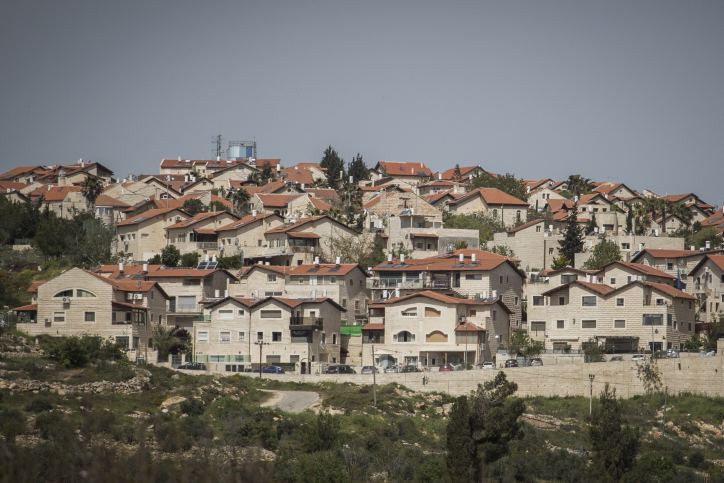Founded 1977 | Area 4.841 km² | |
 | ||
Name meaning Zeev's Hill (also: Wolf Hill) Weather 14°C, Wind W at 19 km/h, 68% Humidity | ||
Ramat givat zeev
Giv'at Ze'ev (Hebrew: גִּבְעַת זְאֵב) is an Israeli settlement in the West Bank, five kilometers northwest of Jerusalem. The town was founded in 1977 on the site of the abandoned Jordanian military camp, adjacent to the site of ancient Gibeon. While it lies within the borders of the Matte Binyamin Regional Council, it is a separate municipal entity. In 2015 it had a population of 16,123.
Contents
Map of Giv'at Ze'ev
The international community considers Israeli settlements in the West Bank illegal under international law, but the Israeli government disputes this.
Description
Giv'at Ze'ev, named after Ze'ev Jabotinsky, was founded in 1977 on confiscated Palestinian land and was declared a local council in 1983. Palestinians contend that under the expropriation maps contained in military orders, the road connecting it to Jerusalem, though ostensibly designed to "facilitate Palestinian movement", actually would confiscate 15 square kilometers of prime agricultural land, on which the livelihoods of 24,000 Palestinians depend in order to enable the programmed development of this settlement bloc. One local Palestinian landowner protesting the land confiscations occupied his plot nearby and refused to be intimidated by settlers shooting in the air. He was eventually scooped up by the blade of a bulldozer and removed.
In 1996 a program of expansion with new housing units and an envisaged 20,000 new settlers was approved, to be constructed on land confiscated from the Palestinian villages of Beitunia, Biddo, and Jib, in what Palestinians call Wadi Salman, but which the Israelis have renamed Ha'ayalot valley Twice in successive years further areas amounting to 250 acres were confiscated from Beitunia and Jib to build an additional 11,550 units. On March 9, 2008, Prime Minister Ehud Olmert approved the construction of 750 new homes in Giv'at Ze'ev under the Agan Ha'ayalot project. This approval stands in contrast to Olmert's policy of freezing new permits for expansion within existing settlements. Olmert argued that the project was first approved in 1999, but stopped in 2000, as a result of the Second Intifada. The approval was criticized by the Palestinian Authority, US Secretary of State Condoleezza Rice, and the European Union. On the political right, the Shas party took credit for pressuring Olmert to approve the project.
Giv'at Ze'ev is one of five settlement "blocs" that, according to the Jewish Virtual Library, "[m]ost Israelis believe [] should become part of Israel when final borders are drawn" and "both Prime Minister Sharon in 2005 and Prime Minister Benjamin Neyantahu in 2010 have repeatedly said the large settlement blocs will “remain in our hands.”"
Both the Ayelet HaShahar synagogue and yeshiva built on private Palestinian land owned by the Allatif family of the nearby Palestinian township of Jib, are slated to be demolished by March 2014, after the prosecutor's office determined that the putative documents of land purchase were forgeries.
Giv'at Ze'ev has four elementary schools and one junior high school. There are two youth movement branches: the Israeli Scouts (Arava tribe) and Bnei Akiva.
Location
It is located just off Highway 443, affording easy access to both Jerusalem and the Tel Aviv area. It is connected to Jerusalem by Egged Ta'avura bus routes 131, 132, 133, 134 and to Tel-Aviv by Egged bus number 471. The loop circling Giv'at Ze'ev effectively annexes over 18 square miles of Palestinian land. The town is patrolled by Mishmeret Ha'gvul and a local security force, and is secured by a security fence. Plans are underway to set a guard post near the entrance to route 443 (currently, the road is closed off by a security fence).
Religious Life
The religious population in mixed and includes Chardal, Dati Leumi, Charedi and Secular. There are about 20 orthodox synagogues in the town, with more expected to be built as the community expands.
Giv'at Ze'ev is the center of the Karlin-Stolin Chasidim and one of the town's most notable residents is the Stoliner Rebbe Boruch Yaakov Meir Shochet. There is also a Chabad Lubavitch community there as well.
Ramat Givat Zeev
Ramat Givat Zeev is a new section that is currently being developed. There are building 400 housing units with both houses and apartments. It is marketed towards English speaking religious Jews, who are making Aliyah to Israel.
